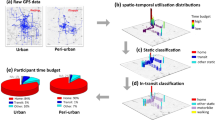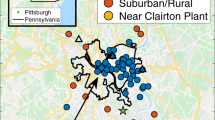Abstract
A photoelectric aerosol sensor (PAS) was used to measure real-time indoor concentrations of polycyclic aromatic hydrocarbons (PAHs) at three residences. Semi-quantitative measurements of total indoor particle-bound PAH and temperature were collected continuously every minute for approximately 2 weeks at each location. The purpose of this study was to examine the effect of traffic on indoor concentrations of PAHs. This was accomplished by collecting indoor measurements at an urban, semi-urban, and suburban residential location with varying levels of, and proximity to, traffic. Since the homes were occupied, the effects of cooking, the dominant indoor source, were also examined among the three nonsmoking households. The results indicate that traffic was the main outdoor source of PAH concentrations measured indoors for all locations. In fact, a significant ( p<0.001) traffic-related trend in weekday PAH concentration was detected with a geometric mean concentration at the urban location (31 ng/m 3) nearly two times that at the semi-urban location (19 ng/m 3) and over three times larger than the suburban location (8.0 ng/m 3), once adjusted for indoor sources. Hourly average concentration profiles also revealed weekday rush hour peaks of PAHs at all locations. No pronounced peaks and significantly lower concentrations (10, 10, and 4.9 ng/m 3) were seen during the weekends for all locations i.e., the urban, semi-urban and suburban locations, respectively. Indoor sources including frying/sautéing, broiling, and candle-burning were characterized by peak concentration, duration of PAH elevation, and potential dose. This analysis suggests that cooking, and especially frying/sautéing, may be an important source of indoor PAH concentrations.
This is a preview of subscription content, access via your institution
Access options
Subscribe to this journal
Receive 6 print issues and online access
$259.00 per year
only $43.17 per issue
Buy this article
- Purchase on Springer Link
- Instant access to full article PDF
Prices may be subject to local taxes which are calculated during checkout
Similar content being viewed by others
Author information
Authors and Affiliations
Corresponding author
Additional information
This paper has been reviewed in accordance with the US Environmental Protection Agency's peer and administrative review policies and approved for presentation and publication. Mention of trade names or commercial products does not constitute endorsement or recommendation for use.
Rights and permissions
About this article
Cite this article
DUBOWSKY, S., WALLACE, L. & BUCKLEY, T. The contribution of traffic to indoor concentrations of polycyclic aromatic hydrocarbons†. J Expo Sci Environ Epidemiol 9, 312–321 (1999). https://doi.org/10.1038/sj.jea.7500034
Received:
Revised:
Published:
Issue Date:
DOI: https://doi.org/10.1038/sj.jea.7500034
Keywords
This article is cited by
-
An overview on remediation technologies for polycyclic aromatic hydrocarbons in contaminated lands: a critical approach
Environment, Development and Sustainability (2023)
-
On mixed metric dimension of polycyclic aromatic hydrocarbon networks
Chemical Papers (2022)
-
Occupational and environmental impacts of indoor air pollutant for different occupancy: a review
Toxicology and Environmental Health Sciences (2021)
-
Predictors of polycyclic aromatic hydrocarbon exposure and internal dose in inner city Baltimore children
Journal of Exposure Science & Environmental Epidemiology (2017)
-
Temporal and spatial variability of particle-bound polycyclic aromatic hydrocabons in Bogota, Colombia
Air Quality, Atmosphere & Health (2014)



